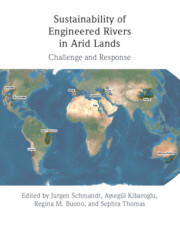Book contents
- Sustainability of Engineered Rivers in Arid Lands
- Sustainability of Engineered Rivers in Arid Lands
- Copyright page
- Dedication
- Contents
- Contributors
- Part I Introduction
- Part II Challenge
- Part III Engineered Rivers
- 7 The Nile River Basin
- 8 The Euphrates–Tigris River Basin
- 9 The Yellow River Basin
- 10 The Murray–Darling River Basin
- 11 The São Francisco River Basin
- 12 The Limarí River Basin
- 13 The Colorado River Basin
- 14 The Rio Grande / Río Bravo Basin
- 15 The Jucar River Basin
- Part IV Response
- Part V Conclusion
- Index
- References
13 - The Colorado River Basin
from Part III - Engineered Rivers
Published online by Cambridge University Press: 16 September 2021
- Sustainability of Engineered Rivers in Arid Lands
- Sustainability of Engineered Rivers in Arid Lands
- Copyright page
- Dedication
- Contents
- Contributors
- Part I Introduction
- Part II Challenge
- Part III Engineered Rivers
- 7 The Nile River Basin
- 8 The Euphrates–Tigris River Basin
- 9 The Yellow River Basin
- 10 The Murray–Darling River Basin
- 11 The São Francisco River Basin
- 12 The Limarí River Basin
- 13 The Colorado River Basin
- 14 The Rio Grande / Río Bravo Basin
- 15 The Jucar River Basin
- Part IV Response
- Part V Conclusion
- Index
- References
Summary
The Colorado is a river in transition – a newly “closed” basin where demands have exhausted reliable supplies. Decades of often short-sighted management decisions have contributed to the crisis environment that currently surrounds the Colorado River. Over the past fifteen years, however, stakeholders and managers have enacted significant changes to the rules and regulations governing the Colorado, and additional reforms remain close to enactment. Unlike the deal-making that characterized negotiations in the twentieth century, recent efforts focus primarily on strategies to promote coordinated management, reduce consumption, and restore a more holistic watershed perspective to a river that was legally apportioned long ago among a highly complex amalgam of jurisdictions and water users. In many respects, the river management system is a successful example of adaptation to changing social and hydrological conditions. Yet, it remains an open question whether the pace and scale of reform is sufficient to deal with the basin’s future.
Keywords
- Type
- Chapter
- Information
- Sustainability of Engineered Rivers In Arid LandsChallenge and Response, pp. 164 - 180Publisher: Cambridge University PressPrint publication year: 2021



